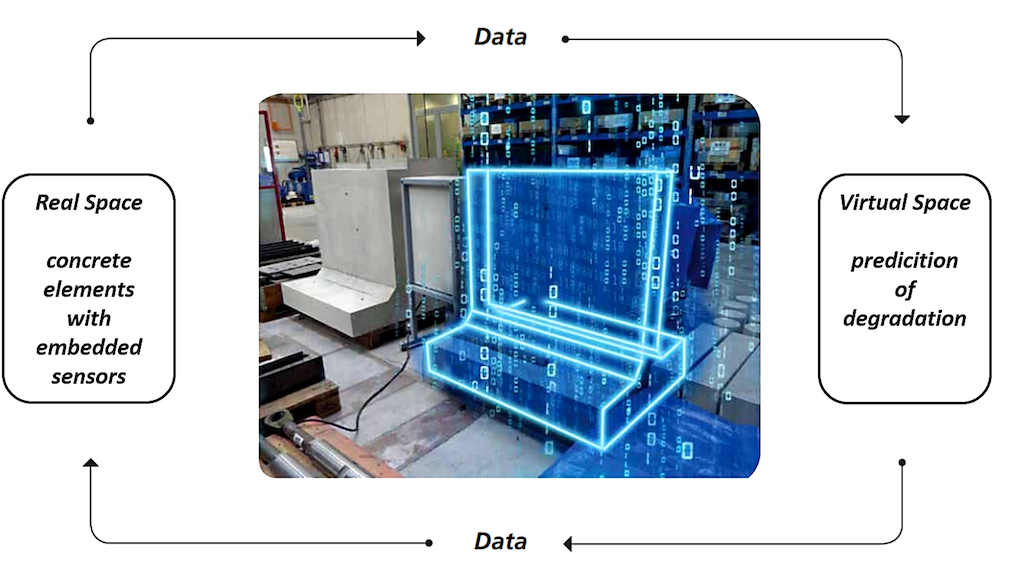Development of a Digital Twin to predict the Degradation of Cementitious Materials for critical Infrastructure Constructions

↵
| Name | Institute |
|---|---|
| Peter Thissen | Institute of Concrete Structures and Building Materials (IMB) |
| Frank Dehn | Institute of Concrete Structures and Building Materials (IMB) |
| Ammar Mahmood | Institute of Concrete Structures and Building Materials (IMB) |
| Vladislav Kvitsel | Institute of Concrete Structures and Building Materials (IMB) |
| Carla Neuhaus | Institute of Concrete Structures and Building Materials (IMB) |
| Michael Vogel | Institute of Concrete Structures and Building Materials (IMB) |
Critical infrastructure constructions (such as tunnels and bridges) made of cementitious materials are often exposed to climatically unfavorable conditions leading to severe degradation and damage to these structures. Specifically, the current global warming and climate change, in general, exacerbates this problem. In this project, we want to develop a digital-twin-based model as a planning tool for operators of such critical infrastructure constructions. By comparing data from external and built-in sensors, e.g., both measuring temperature, moisture, and pH values, we will find out how the local climate impacts the degradation of cementitious materials in different locations over long times. This model will then be expanded to include additional sensor parameters such as CO2- and chloride-concentration, while the network of structures carrying sensors will be expanded as well. A digital twin, based on a kinetic Monte-Carlo algorithm, grants semi-empiric predictability of site-dependent degradation, aiding careful planning of infrastructural measures.
Climate change has become one of the most critical long-term problems of the Anthropocene. Although humanity has measured and predicted the weather for hundreds of years, the effect of changing environmental conditions on critical infrastructural constructions (such as tunnels and bridges) has rarely been studied. Early measurements were limited to local, ground-level temperature and pressure. With satellites and global networks of weather stations, more and broader data has become available, also tracking humidity, height-dependent weather, ozone content, dust content, wind velocities, and many more.
With the technological and scientific advances of the last century, it has even become possible to correlate drastic changes in climate to a changing CO2 content in the historical earth’s atmosphere.
This project is divided into two parts. First, we want to put the experimental focus on building a network of sensors in critical infrastructure constructions. This network of sensors ultimately leads to broad climate and weather-dependent information on the degradation of cementitious materials used for critical infrastructure constructions. It will be possible by connecting the data from our sensors with data from the “Deutscher Wetterdienst” (DWD) and detailed terrain maps.
Initially, the sensors will only probe internal and external temperature and moisture of the critical infrastructure constructions, as well as their electrical resistance. The result will already provide sufficient data on temperature correlation and degradation of cementitious materials. Still, in the later stages of the project, newly developed sensors will additionally monitor chemical parameters like CO2- and chloride-concentration. These sensors will also enable higher spatial resolution of the data.


The sample blocks will have a size of 30 x 30 x 160 cm3 and will be standing upright. The sensors inside will be placed in a grid to receive direction-dependent (cardinal direction) data. Outside of every sample block, a small electronic data logger will be installed, which collects all information from the sensors.
By comparing the received data over time, we will be able to correlate the macroscopic stability with critical processes like the carbonation of the cementitious materials, while also gaining insight on the time dependency of these processes themselves.
The broad collection and analysis of the data from this network will be done via a newly set up online monitoring system. The corresponding platform (website) will later also be the primary way of distributing the results to customers.

